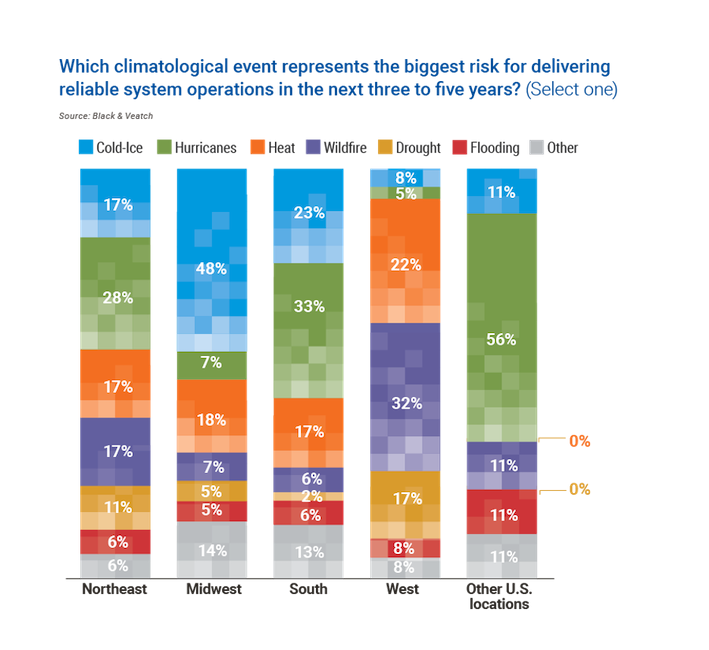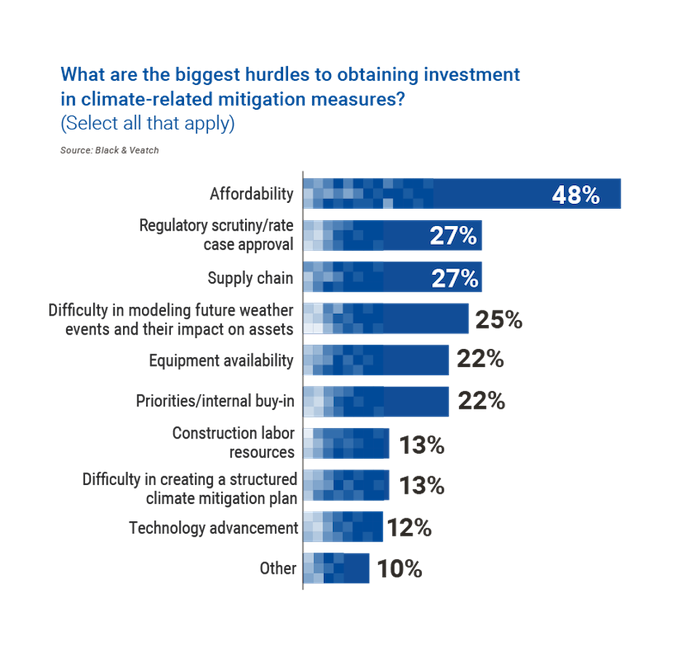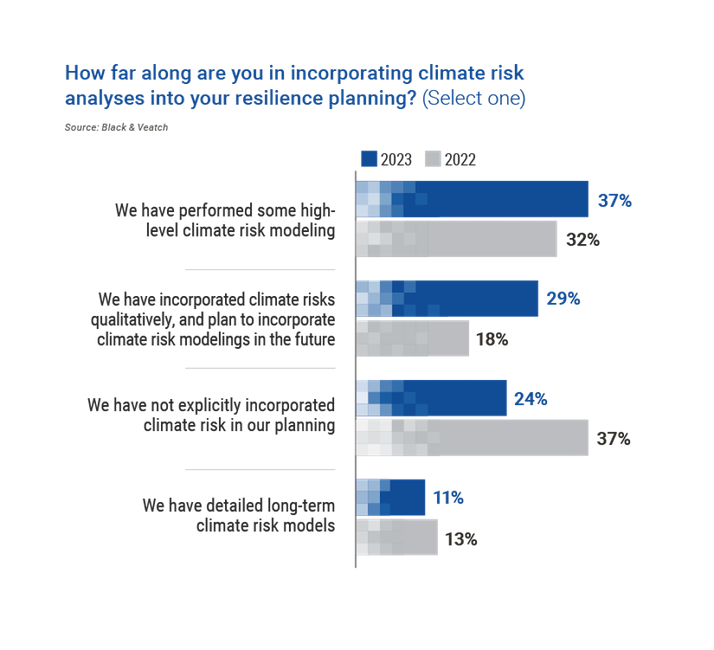Climate Change Preparedness Means Planning
By The Black & Veatch Insights Group
The escalating frequency and strength of hurricanes, wildfires, floods, droughts and environmental impacts offer tangible evidence that climate change is making severe weather events increasingly unpredictable and more costly.
It begs the question: With the ever-present effects of climate change influencing the world, how are electric utilities dealing with the risks?
Black & Veatch’s survey of more than 650 U.S. electric industry stakeholders for its recently released 2023 Electric Report offers some perspective, beginning with the certainty that no utility or locale is immune from climatological risk.
Threats from Every Direction
No matter a utility’s location, some level of threat exists and is top of mind for power providers.
In the Northeast and South, respondents cited hurricanes as their top risk to successfully delivering reliable operations over the next three to five years, while those in the Midwest pointed to cold and ice. In the West, wildfires topped the list of climatological concerns.
Even though many utilities in the same region may face the same risks, the biggest risk they identify varies across the numerous types of threats. In other words, it seems that nothing is off the table when it comes to climatological events that could impact system operations.
Mitigating Risk
The U.S. Department of Energy has been beating the drum about the need for U.S. electric utilities to harden assets in pursuit of resilience and reliability, appreciative that there’s no panacea.
“There is no silver bullet technology to guarantee a reliable system, and every resource and system is at risk for failure: coal or natural gas fuel supplies can freeze, extended periods of low wind resource can occur, and transmission lines can fail,” the DOE warned in July 2022. “Reliability and resilience of the system stems from a portfolio of technologies and strategies that limits exposure to common risks and includes forward planning that considers the evolving threats from climate change, extreme weather and other unknown sources.”
Mitigating climate risk will require utilities to make sizable investments to bolster their infrastructure — an approach that champions being proactive rather than reactively addressing the fallout, both monetarily and in terms of public perceptions and relations – after a disaster hits.
While many electric utilities see merit in bolstering their infrastructures’ climate resilience, getting regulatory signoff for the often-steep price tag — and recovering that cost from ratepayers likely to object — keeps such projects from being viable, no matter the utility’s commitment to it.
But Uncle Sam is offering some help with climate-related investment infusions that started with the $1.2-trillion Infrastructure Investment and Jobs Act (IIJA) that earmarks $73 billion for grid upgrades, including the buildout of thousands of miles of new, resilient transmission lines to help expand renewable energy ostensibly meant to mitigate climate change. That single biggest federal investment in power transmission in U.S. history comes at a time of runaway expansion of renewables.
The “Inflation Reduction Act” (IRA) that followed became the single biggest climate investment commitment in U.S. history, with $369 billion over 10 years devoted to climate and clean energy provisions. That includes some $30 billion in grant and loan programs for electric utilities and states to advance the transition to cleaner, greener energy.
These historical measures will significantly benefit utilities looking to harden their systems against climate change events, especially given that respondents cited affordability (48 percent) as the chief obstacle to climate-related mitigation measures. However, other challenges remain, including both regulatory scrutiny and supply chain logjams (both at 27 percent), the latter manifested by the COVID-19 pandemic and not expected to ease in the near-term. Difficulty in modeling future weather events and their impact on assets drew one-quarter of respondents, reflecting the complexity of modeling the dynamic variables related to climatological changes and their impact on electric utility infrastructure.
A Focus on Planning
Despite the hurdles, the U.S. electric sector appears to be putting a major focus on planning.
According to respondents, two-thirds of utilities have incorporated climate risk analysis into their resilience planning or performed high-level climate risk modeling. This number has gone up substantially from 50 percent last year, punctuating the point that utilities are taking this risk more seriously.
Developing Unique Solutions
Utilities seemingly are taking climate risks seriously by implementing planning into their strategies, knowing that there’s no one-size-fits-all approach, even within one geographic region. It is imperative that we act now by discarding outdated planning methods and adopting new ones that incorporate climate modeling and other innovative climate-mitigation strategies to enhance our resilience against the escalating frequency and severity of climate-related events.
For More Information
When it comes to effective climate modeling and other tools to help utilities better prepare for their futures, the analysis comes to three key considerations – location, past weather event history and climate change models. To learn more about this topic in a Black & Veatch eBook, click here.





